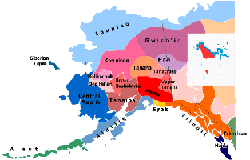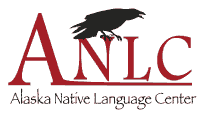Tanacross

Tanacross is the ancestral language of the Mansfield-Ketchumstock and Healy Lake-Joseph Village bands. It is spoken today at Healy Lake, Dot Lake, and Tanacross on the middle Tanana River. The total population is about 220, of whom about 65 speak the language.
The name Tanacross derives from the English name Tanana Crossing, a ford on the Eagle Trail. The indigenous name for the language is Nee'anděg'.
A practical alphabet was established in 1973 and a few booklets have been published at the Alaska Native Language Center. In 2009 the Tanacross Learners' Dictionary, compiled by Irene Arnold, Rick Thoman, and Gary Holton, was published.
Dihthaad Xt'een Iin Aandeg'

The word Tanacross has been used to refer both to a village in eastern Alaska and
to the language spoken there. A more appropriate term may be Dihthaad Xt'een Aandeg' The Mansfield People's Language, referring to the traditional village of Mansfield,
north of Tanacross. (See more on the history of the name Tanacross.) The modern village of Tanacross is accessible by a short access road from the Alaska
Highway, and some speakers now reside in the regional center of Tok, located approximately
ten miles east of the village on the highway. In addition several speakers now reside
in the nearest commercial center of Fairbanks, located two hundred miles downstream
from Tanacross village and accessible by all-weather highway.
Tanacross is the ancestral language of the Mansfield-Ketchumstuk and Healy Lake-Joseph
Village bands of Athabascan people, whose ancestral territory encompassed an area
bounded by the Goodpaster River to the west, the Alaska Range to the south, the Fortymile
and Tok Rivers to the east, and the Yukon Uplands to the north.
 The History of the Name Tanacross
The History of the Name Tanacross
The word Tanacross has been used to refer both to a village in eastern Alaska and to an ethnolinguistic group. The modern village of Tanacross is accessible by a short access road from the Alaska Highway, and some speakers now reside in the regional center of Tok, located approximately ten miles east of the village on the highway. In addition several speakers now reside in the nearest commercial center of Fairbanks, located two hundred miles downstream from Tanacross village and accessible by all-weather highway. Unless otherwise modified, I use the term Tanacross to refer to a language.
In the late nineteenth century trading posts were established at Tanana Crossing, a ford along the Eagle Trail, directly across the Tanana River from the present-day village of Tanacross. A telegraph station followed in 1902, and St. Timothy's Episcopal mission was established in 1909. Both the Mansfield-Ketchumstuk and Healy Lake-Joseph Village bands eventually settled in Tanana Crossing, eventually shortened to Tanacross (McKennan 1959). The village was relocated across the river to its present location in the early 1970’s, and most present-day Tanacross speakers live in or near the village of Tanacross.
The name Tanacross has only recently been applied to the language and still has limited currency outside academic circles. Many other logonyms have been used. Wrangell’s 1839 wordlist refers to the language as the "Copper River Kolchan", though Wrangell certainly had no notion of the linguistic geography of the Tanacross region. The first extensive ethnographic research in the area was conducted by McKennan in 1929-30, who excludes Tanacross from his map of what he labels as the Upper Tanana region (1959: 16). However, McKennan later appears to lump Tanacross and Upper Tanana together under the label Upper Tanana, noting:
"In considering the Tanana River as a whole, however, the [Tanana] Crossing and Upper Tanana natives should be lumped together, for between the Crossing and Healy River occur a whole series of rapids which today make navigation exceedingly dangerous and in earlier days practically prevented it." (pg. 23)
McKennan mistakenly assumes that the Tanana River was a major transportation corridor, when in fact the various Tanacross bands have never had a true riverine culture, having only settled on the Tanana River in the twentieth century. The rapids referred to by McKennan serve as a barrier to salmon migration and remove a major incentive for river settlement (de Laguna & McClellan 1960). In contrast, land travel in this region is relatively easy, and extensive networks of trails connect the villages of the Tanacross region. Many of these trails are still used for hunting access. And at least until the construction of the Alaska Highway in 1942, foot and sled travel between Healy Lake, Mansfield and Ketchumstuk was extremely common (Ellen Demit, personal communication). Osgood (1936) uses the term Tanana for the entire region of the Tanana River drainage below the Tok River to the confluence of the Tanana and Yukon rivers. Shinen (1958), who recorded a word list from Mary Charlie and Oscar Isaac in Tanacross village, refers to the language as the "Nabesna dialect", and Shinen’s term was repeated in Hoijer (1963). Nabesna was actually Osgood’s preferred term for Upper Tanana, so Shinen appears to have followed McKennan in lumping Tanacross and Upper Tanana together but adopted Osgood’s logonym. Shinen’s list is clearly of Tanacross, not Upper Tanana origin. De Laguna & McClellan (1960) use the term Tanacross language, but only in a restricted sense referring to the language of Tanacross village proper. Krauss originally included Tanacross with Lower Tanana, but after a more extensive linguistic survey of the region in the 1960’s, he began using the term "Transitional Tanana", recognizing the distinction between Tanacross and the remainder of Tanana (Krauss, p.c.). As the significance of this distinction grew to justify a language rather than dialect boundary, the name Tanacross was applied to the Tanacross linguistic region, appearing for example in Krauss’ 1973 survey of the Athabaskan languages. The preferred self-designation for the language (in English) is simply "Indian", though "Native Language" is sometimes used in more formal contexts. The term "Athabascan" is also sometimes used. (See Michael Krauss' article for more information on the spelling of this name.) Today the indigenous word Nee'aandeg 'our language' is often heard to refer to the language.
References
McKennan, Robert A. 1959. The Upper Tanana Indians. (Yale University Publications in Anthropology 55). New Haven: Yale University Department of Anthropology.
Krauss, Michael E. 1973b. Na-Dene. Linguistics in North America, ed. by Thomas A. Sebeok, 903-78. (Current Trends in Linguistics 10). The Hague: Mouton.
de Laguna, Frederica & Catherine McClellan. 1960. Tanacross fieldnotes. Manuscript, Alaska Native Language Center Archives. Fairbanks.
Shinen, David C. 1958. A word list of the Nabesna dialect of the Alaska Athapaskans. Manuscript, Alaska Native Language Center Archives. Fairbanks.
Osgood, Cornelius. 1936. The distribution of the northern Athapaskan Indians. (Yale University Publications in Anthropology, no. 7.) New Haven: Yale University.
Tanacross Learners' Dictionary
The Tanacross Learners' Dictionary is intended as a reference for anyone wanting to learn the spoken language. Words are organized by English headword. The subject matter and the level of complexity are varied enough to make the dictionary a useful resource for a wide range of users: from people who know nothing of the language to people know some words and phrases or have heard the language being spoken by their parents or grandparents.
The Tanacross Learners' Dictionary is a community based project. Many of the Tanacross words and example sentences include audio recordings which illustrate pronunciation. However, some of words included here may be pronounced differently by different speakers, and there is often more than one way to say something. Some of these differences are included in the dictionary, but vocabulary in the dictionary should not be considered to be the only correct way to say something.
The online version of this dictionary represents a preliminary version current as of 2006. The print version of the dictionary, published in 2009, can be ordered from ANLC.
Tanacross Learners' Dictionary, click here to learn more about the project.
The Sounds of Tanacross
 a multimedia project for language learning
a multimedia project for language learning
We are extremely grateful to the Tanacross Elders, speakers and community members who have supported this project. We especially wish to thank Irene Arnold, Laura Sanford and Kenny Thomas, each of whom has consented to sharing their knowledge of the Tanacross language by being recorded and appearing on this CD.
 |
 |
 |
| Irene Solomon-Arnold | Laura Sanford | Kenny Thomas, Sr. |
Click here to learn more about the project.
Common Expression
| tsin'ęę | thank you |
Links and Resources
 Learn More:
Learn More:
Alaska is home to at least twenty distinct indigenous languages. More than just dialectal variants, these different languages reflect the cultural heritage of Alaska's Native peoples. For more information about particular languages, click below.


